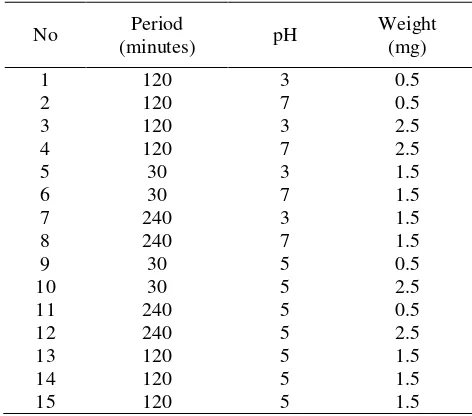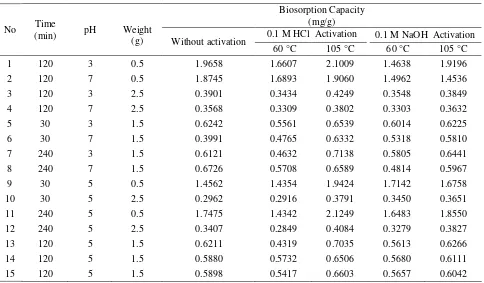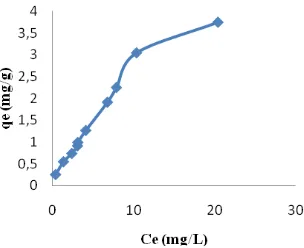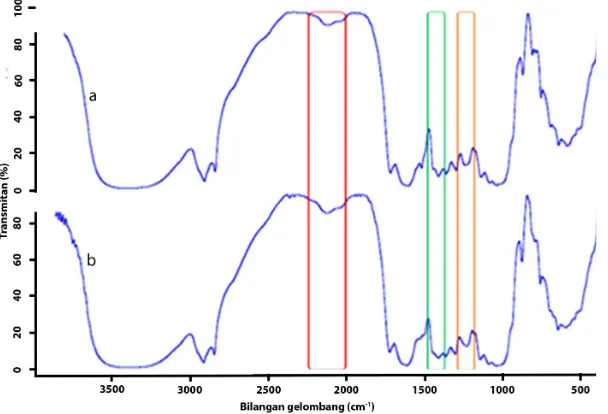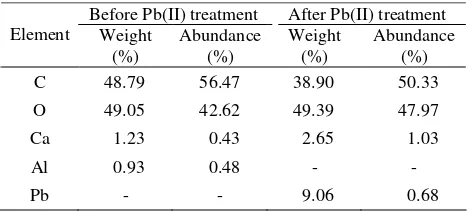Sansevieria trifasciata
Properties as Lead(II) Ion Biosorbent
Lela Mukmilah Yuningsih
1, Irmanida Batubara
2,3, and Latifah Kosim Darusman
2,31. Universitas Muhammadiyah Sukabumi, Sukabumi 43113, Indonesia
2. Department of Chemistry, Faculty of Mathematics and Natural Sciences, Institut Pertanian Bogor, Bogor 16680, Indonesia
3. Biopharmaca Research Center, Institut Pertanian Bogor, Bogor 16151, Indonesia E-mail: [email protected]
Abstract
Sansevieria trifasciata (also called snake plant or mother in law’s tongue) is predicted to act as a heavy metal biosorbent. S. trifasciata was optimized as a biosorbent by using the response surface method with varying weights of S.
trifasciata, pH of Pb (II) solutions, contact times, and temperatures. The ion concentration before and after biosorption was measured with an atomic absorption spectrophotometer (AAS). The optimum biosorption conditions were pH 7, 240 min contact time, and 1.5 g biosorbent with biosorption capacity of Pb (II) ions 0.725 mg/g. The biosorption isotherm analysis showed that the biosorption is consistent with the Freundlich isotherm model. The peak intensity of the FTIR spectrum of S. trifasciata after treatment with Pb (II) was around 2130/cm. The S. trifasciata micrograph showed a porous structure with non-uniform pore sizes. The biosorption of Pb (II) ions on powdered S. trifasciata leaves was found with the SEM EDX analysis. It is concluded from this research that S. trifasciata can be used as a biosorbent to remove Pb ion contamination.
Abstrak
Biosorpsi Ion Timah Hitam (II) Menggunakan Sansevieria trifasciata Prain. Sansevieria trifasciata (yang dikenal sebagai tumbuhan ular atau lidah mertua) diduga dapat menjadi biosorben logam berat. Konsentrasi ion logam Pb (II)
sebelum dan sesudah biosorpsi diukur dengan spektrofotometer serapan atom (SSA). Optimasi kemampuan S. trifasciata sebagai biosorben dilakukan menggunakan metode respon surface dengan variasi pada massa tumbuhan, pH larutan, waktu kontak, dan suhu. Kondisi biosorpsi optimal diperoleh pada pH 7, waktu 240 menit dan berat S. trifasciata 1.5 g dengan kapasitas biosorpsi Pb (II) sebesar 0.725 mg/g. Analisis isoterm adsorpsi menunjukkan biosorpsi mengikuti model isotherm Freundlich. Spektrum FTIR daun lidah mertua setelah diperlakukan larutan timah hitam (II) memperlihatkan intensitas puncak pada daerah 2130/cm. Mikrograf daun lidah mertua memperlihatkan struktur berpori dengan ukuran yang tidak seragam. Penyerapan Pb (II) pada serbuk daun S. trifasciata diketahui melalui analisis SEM EDX. Berdasarkan hasil penelitian, dapat disimpulkan bahwa S. trifasciata dapat digunakan sebagai biosorben untuk menghilangkan kontaminasi ion Pb.
Keywords: biosorption, heavy metal, response surface method, Sansevieria trifasciata
1.
Introduction
Lead is a hazardous contaminant. Accumulation of this metal in the human body causes various adverse health effects, such as osteoporosis, reproductive organ damage, brain damage, and acute toxicity to the central nervous system. According to the World Health Organization (WHO) and the U.S. Environmental Protection Agency (U.S. EPA), the drinking water standards for lead are 10 µg/L and 50 µg/L, respectively, while the wastewater standard for lead
according to the EPA is 500 µg/L [1]. Lead enters the body through food absorption (65%), water (20%), and air (15%).
the extent of pollution due to the metallic species of the industrial effluents. Cost is an important parameter for comparing sorbents [2]. Thus, using indigenous biodegradable resources for treating hazardous waste would be less expensive.
Biosorption is a process in which heavy metals are adsorbed by materials of natural origin. Biological materials that are used as biosorbents include marine algae, bacteria, fungi, and crab shells.
Sansevieria trifasciata (also called snake plant or mother in law’s tongue)is expected to have potential as a biosorbent to adsorb heavy metals. S. trifasciata has been reported as a potent adsorbent of hazardous pollutants in wastewater because it contains pregnane glycosicides, which reduce the pollutant into organic acid, sugar, and amino acid, resulting in a non-hazardous pollutant to humans [3]. In recent years, the biosorption process has been studied extensively using biomass as biosorbents for heavy metal removal such as ponkan peel [4], Garcinia mangostana L. fruit shell [5], and black cumin [6].
The objective of this research was to determine the potency of S. trifasciata leaf powder as a biosorbent in adsorbing Pb (II) ions. The determination of S. trifasciata potency as a biosorbent was started by analyzing the capability of S. trifasciata dry powder in adsorbing Pb (II) ions in solution. Pb (II) adsorption of S. trifasciata was optimized by using the response surface method by varying the weight of S. trifasciata, pH of Pb (II) solutions, contact times, and temperatures. The experiment design for second-order response surface used central composite design (CCD) or Behnken design. There was no axial/star run in the Box-Behnken according to this design, which resulted in fewer experiment units involved in the Box-Behnken, and eventually, a more efficient design was generated.
2.
Methods
Materials. The materials used in this research were leaves of S. trifasciata, Pb(NO3)2 crystalline, 0.1 M
NaOH, 0.1 N HNO3,and 0.1 M HCl.
Sample preparation. Sansevieria trifasciata leaves were washed with flowing water and then dried with tissue. Then, the dried leaves were cut into pieces, dried in an oven at 60 °C for 3 × 24 h, and turned into powder by using a blender in order to produce a uniform size and reduce the moisture content to 4.08%.
Sansevieria trifasciata activation. S. trifasciata activation was performed by steeping the powdered leaves of S. trifasciata in 0.1 M HCl and 0.1 M NaOH for 24 h, and then straining and washing them using
deionized water until neutral. The powder was heated at 60 and 105 °C for 24 h.
Experimental design. The Box-Behnken response surface method was used in this experiment. The parameters for the optimization process were pH in the range of 3-7 [7], weight of biosorbent used, i.e., 0.5, 1.0, 1.5, 2.0, 2.5 g [8], and contact time of 30, 60, 120, 180, and 240 min [8]. The experiment parameters are shown in Table 1.
Lead (II) ions biosorption of S. trifasciata. The method for Pb (II) ions biosorption was Bingol et al.’s modified method [6]. Pb (II) aqueous solution, 50 mL each, was added with various weights of S. trifasciata powder: 0.5, 1.0, 1.5, 2.0, and 2.5 g. The mixture was mixed in a shaker (55 rpm) for a given period, 5-10 drops of 1 M NaOH or 1 M HCl were added, and filtered with a Buchner funnel, and the supernatant was collected. The supernatant was analyzed with AAS at 283.3 nm. Analysis of Lead (II) ion biosorption of S. trifasciata used the acid- and base-activated powdered S. trifasciata leaves and non-activated powdered leaves. Biosorption isotherm. A 100 ml Pb (II) aqueous solution at various concentrations of 10, 20, 30, 40, 60, 80, 100, 120, and 140 mg/L was added to 1.5 g of powdered S. trifasciata leaves, and stirred under optimal conditions and room temperature. The solution was then filtered, and the concentration was determined using AAS. The biosorption capacity (Q) was calculated by using the Langmuir and Freundlich isotherm model,
V
Table 1. Box-Behnken Response Surface Parameters for Pb(II) Ion Biosorption of S. trifasciata with and without Acid and Base Activation
in which:
Q = biosorption capacity per unit weight of biosorbent (mg metal /g biosorbent)
V = solution volume (L)
The percentage of heavy metal ion biosorption can be calculated by using the following formula:
%
100
%
1 2
1
×
−
=
C
C
C
n
Biosorptio
(2)C1 = solution initial concentration (mg/L)
C2 = solution final concentration (mg/L)
m =biosorbent weight (g)
Biosorbent characterization. The morphology of the trifasciata leaves before and after treatment with Pb (II) and the content of the elements in the leaves and functional groups was characterized using SEM (Scanning Electron Microscope), EDX, and FTIR, respectively.
The morphology of the S. trifasciata leaves before and after treatment with Pb (II) was characterized by using SEM JEOL JSM-G510 LA, the content of the elements in the leaves was determined by using EDXJEOL 2605 LA, and characterization of functional groups was performed by using FTIR Prestige-21 Shimadzu.
3.
Results and Discussion
The results of this research show that S. trifasciata can be used as a biosorbent to adsorb Pb (II) ions. Table 2 presents the biosorption capacity and percent biosorption of Pb (II) ions of S. trifasciata with and without acid and base activation at heating temperatures of 60 °C and 105 °C.
Based on the biosorption capacity and percent biosorption data, the biosorption of Pb (II) ions by S. trifasciata activated by 0.1 M HCl and heated at 105 °C resulted in the highest biosorption capacity and percent biosorption, i.e., 2.12 mg/g and 98%. This condition was then used for the optimization process by using the Box-Behnken response surface method.
Optimization of biosorption conditions at various times, pH, and weights had a significant effect on the biosorption capacity. This is shown by the small p-value (p-value of time: 0.042; p-value of pH = 0.034; p-value of weight = 0.000). Based on the optimization results, the following equation model was acquired.
The optimization results for the Pb (II) ion biosorption process at 20 mg/L (Fig.1) shows the biosorption capacity exceeded 0.725 mg/L in a pH range of 3-7, time > 100 min,
Table 2. Biosorption Capacity and Percent Biosorption of Pb(II) ions of S. trifasciata with and without Acid and Base Activation at Heating Temperature of 60 oC and 105 oC
Biosorption Capacity (mg/g)
0.1 M HCl Activation 0.1 M NaOH Activation No Time
(min) pH Weight
(g) Without activation
60 °C 105 °C 60 °C 105 °C
1 120 3 0.5 1.9658 1.6607 2.1009 1.4638 1.9196
2 120 7 0.5 1.8745 1.6893 1.9060 1.4962 1.4536
3 120 3 2.5 0.3901 0.3434 0.4249 0.3548 0.3849
4 120 7 2.5 0.3568 0.3309 0.3802 0.3303 0.3632
5 30 3 1.5 0.6242 0.5561 0.6539 0.6014 0.6225
6 30 7 1.5 0.3991 0.4765 0.6332 0.5318 0.5810
7 240 3 1.5 0.6121 0.4632 0.7138 0.5805 0.6441
8 240 7 1.5 0.6726 0.5708 0.6589 0.4814 0.5967
9 30 5 0.5 1.4562 1.4354 1.9424 1.7142 1.6758
10 30 5 2.5 0.2962 0.2916 0.3791 0.3450 0.3651
11 240 5 0.5 1.7475 1.4342 2.1249 1.6483 1.8550
12 240 5 2.5 0.3407 0.2849 0.4084 0.3279 0.3827
13 120 5 1.5 0.6211 0.4319 0.7035 0.5613 0.6266
14 120 5 1.5 0.5880 0.5732 0.6506 0.5680 0.6111
15 120 5 1.5 0.5898 0.5417 0.6603 0.5657 0.6042
Figure 1. Surface Plot of Pb (II) Ion Biosorption of Acid-activated S. trifasciata
and weight of S. trifasciata 1.3-1.7 g. At the conditions of 120 min, pH 5, weight of S. trifasciata 1.5 g and 240 min, pH 7, weight of S. trifasciata 1.5 g, the highest biosorption capacity and percent biosorption were obtained, and the values were nearly the same, i.e., 0.6603 mg/g and 0.6589 mg/g, and 99.54% and 99.32%, respectively. For the next experiment, the following condition was selected: contact time 240 min, pH 7, and weight of S. trifasciata 1.5 g. This condition may be applied to decrease the Pb level in fishery products contaminated with Pb.
The biosorption capacity of Pb (II) ions of S. trifasciata was lower than that of other reported biosorbents, such as waste from the sugar industry, which has a biosorption capacity of 2.50 mg/g at pH 5 [10], yeast waste, 5.72 mg/g at pH 5.0-6.0 [11], rice husk, 8.60 mg/g at pH 5.0 [12], Spirogyra sp., 140 mg/g at pH 5.0 [1], Aeromonashydrophila, 122 mg/g at pH 5.0 [13], ponkan peel, 112 mg/g at pH 5.0 [4], Garcinia mangostana, 3.56 mg/g at pH 5.0 [5], and black cumin, 8.08 mg/g at pH 5.1 [6]. The advantage of S. trifasciata, however, is that it can be applied at neutral pH; this application is better for fishery food products. S. trifasciata as a biosorbent not only can adsorb hazardous pollutants in the wastewater but can also adsorp heavy metal ions such as lead in the air. S. trifasciata is a low-cost biosorbent and environmentally friendly.
Lead(II) Biosorption Isotherm of S. trifasciata. The biosorption isotherm was determined to find the effect of the initial Pb (II) concentration on the amount of Pb (II) ions adsorbed by the biosorbent at room tem-perature. The Pb (II) biosorption isotherm equilibrium at pH 7, room temperature, is shown in Fig. 2.
The results show that Pb (II) ion biosorption capacity increases with the increase in the Pb (II) initial concentration. This is related to the increasing amount of adsorbate Pb (II) ion interaction in the beginning and later tends to be constant (the surface of S. frisciata becomes saturated).
Figure 2. Pb(II) Isotherm Biosorption of S. trifasciata at Room Temperature (27 °C), Initial Concentration: 10-140 mg/L; pH 7, Weight 1.5 g, and Contact Time 240 Min
(a) (b)
Figure 3. Lead(II) Ions Isotherm Biosorption Curve of S. trifasciata (a) Langmuir and (b) Biosorption Isotherm Freundlich
Figure 4. FTIR Spectrum of S. trifasciata (a) Before and (b) After Treatment with Pb(II)
The presence of the COO-carboxylate group in the biomass is shown by the presence of peaks at 1432/cm and 1383/cm. The peak of the tertiary amine complex is at 1319/cm [15]. The vibration spectrum of the C-O stretch from cellulose is at 1059/cm. The peaks at 894, 835, and 776/cm are the spectrum of the out-of-plane C-H bend.
The FTIR spectrum of S. trifasciata after treatment with Pb (II) shows an increase in the intensity and several peak shifts (Fig. 4b). The increase in the intensity of the peak at the area of 2130/cm and the slight shift show that there was an interaction between the Pb (II) metal and the carbonyl group [16]. The absence of a peak at 1538/cm shows that the nitrogen atom was not the main site for the Lead (II) ion adsorption of S. trifasciata. A change in peak intensity is also seen in 1426–1247/cm showing that there was an interaction between the Pb (II) ions and the carboxylate ion (COO-) [15]. In general, the FTIR spectrum proves the existence of Pb
(II) metal biosorption on the surface of S. trifasciata. The increase in intensity and the slight shift in the peak show that biosorption chemically occurred at heterogeneously active sites. This phenomenon is also supported by the isotherm biosorption data showing that Pb (II) biosorption on the surface of S. trifasciata is a Freundlich biosorption isotherm.
Figure 5. SEM Micrograph of S. trifasciata (a) Before and (b) After Treatment with Pb(II)
Table 6. Elements in S. trifasciata Biosorbent
Before Pb(II) treatment After Pb(II) treatment
Element Weight
(%)
Abundance (%)
Weight (%)
Abundance (%)
C 48.79 56.47 38.90 50.33
O 49.05 42.62 49.39 47.97
Ca 1.23 0.43 2.65 1.03
Al 0.93 0.48 - -
Pb - - 9.06 0.68
The result of the element analysis with SEM EDX (Table 6) shows that the biosorbent of S. trifasciata before treatment with Pb (II) comprises C, O, Ca, and Al. The amount of calcium and aluminum, however, is significantly lower than that of carbon and oxygen, which are the main components in cellulose, hemicellulose, and lignin. The presence of calcium and aluminum in S. trifasciata showed the nutrients that the plant got from soil.
The SEM EDX results show that the weight percentage and Lead abundance are relatively small in the sample analyzed. This is because the mechanism of Pb (II) biosorption on the surface of the biosorbent is mainly through electrostatic attraction between differently charged ions. This mechanism is possible only when the biosorption happens in the aqueous phase where Lead is in its ionic form.
4. Conclusions
Sansevieria trifasciata can be used as a biosorbent to remove Lead ion contamination. The optimum biosorption condition was found at pH 7, 240 min contact time, and 1.5 g biosorbent with biosorption capacity of Pb (II) ion 0.725 mg/g. The equilibrium data were described satisfactorily by the Freundlich isotherm models.
Acknowledgement
The authors gratefully acknowledge Scholarship DIKTI 2011-2013 for financial support.
References
[1] V.K. Gupta, A. Rastogi, J. Hazard. Mater. 152 (2008) 407
[2] D. Xu, X. Tan, C. Chen, X. Wang, J. Hazard. Mater. 154 (2008) 407.
[3] Y. Mimaki, T. Inoue, M. Kuroda, S. Yutaka, Phytochemistry 441 (1997) 107.
[4] F.A. Pavan, A.C. Mazzocato, R.A. Jacques, S.L.P. Dias, Biochem. Eng. J.40 (2008) 357.
[5] R. Zein, R. Suhaili, F. Earnestly, E. Indrawati, E. Munaf, J. Hazard. Mater.181 (2010) 52.
[6] D. Bingol, M. Hercan, S. Elevli, E. Kılıc, Biores. Tech. 112 (2012) 111.
[7] R. Marandi, F.D. Ardejani, H.A. Afshar, J. Min. Environ. Iss. 1 (2010) 581.
[8] B.Y.M. Bueno, M.L. Torem, F. Molina, L.M.S. de Mesquita, Miner. Eng. 21 (2007) 65.
[9] J. Anwar, U.W. Shafique, M. Salman, A. Dar, S. Anwar, Biores. Tech. 101 (2010) 1752.
[10] V.K. Gupta, I. Ali, J. Colloid Interface Sci. 271 (2004) 321.
[11] R. Han, H. Li, Y. Li, J. Zhang, H. Xiao, J. Shi, J. Hazard. Mater 137 (2006) 1569.
[12] M.M.D. Zulkali, A.L. Ahmad, N.H. Norulakmal, Biores. Tech. 97 (2006) 21.
[13] S.H. Hasan, P. Srivastava, M. Talat, J. Hazard. Mater.168 (2009) 1155.
[14] U. Farooq, J.A. Kozinski, M. Khan, M. Athar, Biores. Tech. 101 (2010) 5043.
[15] H. Bairagi, M. Khan, L. Ray, A. Guha, J. Hazard. Mater. 186 (2011) 756.
[16] B.H. Stuart, Infrared Spectroscopy: Fundamentals and Applications, Wiley, New York, 2004, p.244.
